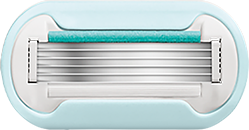
Gillette Venus
Writer and expert • 07 Dec 2022
Ingrown hairs can be itchy, painful and cause redness and swelling. Learn more about what ingrown hairs are, and how to prevent them when shaving.
Ingrown hairs can be itchy, painful and cause redness and swelling. Learn more about ingrown hairs, how to treat them and how to prevent them when shaving.
We all want healthy looking skin after shaving. However, shaving can also lead to razor burn, skin irritation and ingrown hairs. Ingrown hairs can occur after you shave and is the result of cut hair curling back into the skin.
What are ingrown hairs?
After you shave, a cut hair can curl back under the skin and start to grow beneath the surface. This ingrown hair creates a small, skin-colored or red pimple-like bump on your skin, which may or may not contain pus, can be itchy and can cause redness, swelling and pain.

Where do ingrown hairs grow?
You can end up with ingrown hairs anywhere you shave with a razor. With that said, they most often occur in areas with thick, coarse hair such as your armpits and your bikini area. This is because cut hairs can more easily curl back into the skin when the hair is dense and curly.

How do you get rid of ingrown hairs?
In most cases, ingrown hairs will clear up without treatment. To help your skin recover faster, avoid touching the affected area. You can also take steps to speed up the healing process.
Avoid shaving the area with ingrown hairs until they have time to heal.
Soak the area in warm water or apply a warm towel for a few minutes.
Try exfoliating to remove any loose dead skin, which can block the ingrown hair from breaking through the skin’s surface.
Apply a non-greasy moisturizer to help heal dry skin and remove any dead cells.
If you see the hair break through, try to gently pull it out with a pair of sterile tweezers.
See a dermatologist to get a prescription for an antibiotic if an ingrown hair gets infected.

How can you prevent ingrown hairs when shaving?
To protect skin from ingrown hairs, each area of the body requires some different steps when shaving, but below are best practices to follow regardless of where you shave.
1. Change your razor blades frequently Using dull razor blades cause skin irritation, razor burn and ingrown hairs. If you feel your blade pulling at your hair or if it feels rough on your skin, it is most likely dull and should be replaced.
2. Hydrate your skin Soak the area you plan to shave in warm water via a shower or bath for at least three minutes. Hydrating your skin helps the hair cut more easily.
3. Exfoliate regularly Since ingrown hairs are commonly caused by dead skin cells that obstruct the hair from breaking through the skin’s surface, exfoliating regularly will help remove these dead cells.
4. Always shave with shave gel Shaving dry skin can cause razor burn, irritation and ingrown hairs. Always hydrate your skin before you shave, use shaving gel and apply moisturizer post-shave to keep skin hydrated.
5. Be consistent To better protect your skin from ingrown hairs while shaving, it’s important to be consistent and know how to shave each individual area.







